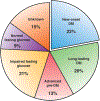Early Detection of Pancreatic Cancer: Opportunities and Challenges
- PMID: 30721664
- PMCID: PMC6486851
- DOI: 10.1053/j.gastro.2019.01.259
Early Detection of Pancreatic Cancer: Opportunities and Challenges
Abstract
Most patients with pancreatic ductal adenocarcinoma (PDAC) present with symptomatic, surgically unresectable disease. Although the goal of early detection of PDAC is laudable and likely to result in significant improvement in overall survival, the relatively low prevalence of PDAC renders general population screening infeasible. The challenges of early detection include identification of at-risk individuals in the general population who would benefit from longitudinal surveillance programs and appropriate biomarker and imaging-based modalities used for PDAC surveillance in such cohorts. In recent years, various subgroups at higher-than-average risk for PDAC have been identified, including those with familial risk due to germline mutations, a history of pancreatitis, patients with mucinous pancreatic cysts, and elderly patients with new-onset diabetes. The last 2 categories are discussed at length in terms of the opportunities and challenges they present for PDAC early detection. We also discuss current and emerging imaging modalities that are critical to identifying early, potentially curable PDAC in high-risk cohorts on surveillance.
Keywords: Biomarker; Pre-diagnostic; Risk Stratification.
Copyright © 2019 AGA Institute. Published by Elsevier Inc. All rights reserved.
Conflict of interest statement
Conflicts of interest:
Figures




References
-
- Ryan DP, Hong TS, Bardeesy N. Pancreatic adenocarcinoma. N Engl J Med 2014;371:1039–49. - PubMed
-
- Kleeff J, Korc M, Apte M, et al. Pancreatic cancer. Nat Rev Dis Primers 2016;2:16022. - PubMed
-
- Ishikawa O, Ohigashi H, Imaoka S, et al. Minute carcinoma of the pancreas measuring 1 cm or less in diameter--collective review of Japanese case reports. Hepatogastroenterology 1999;46:8–15. - PubMed
-
- Furukawa H, Okada S, Saisho H, et al. Clinicopathologic features of small pancreatic adenocarcinoma. A collective study. Cancer 1996;78:986–90. - PubMed
Publication types
MeSH terms
Substances
Grants and funding
LinkOut - more resources
Full Text Sources
Other Literature Sources
Medical

